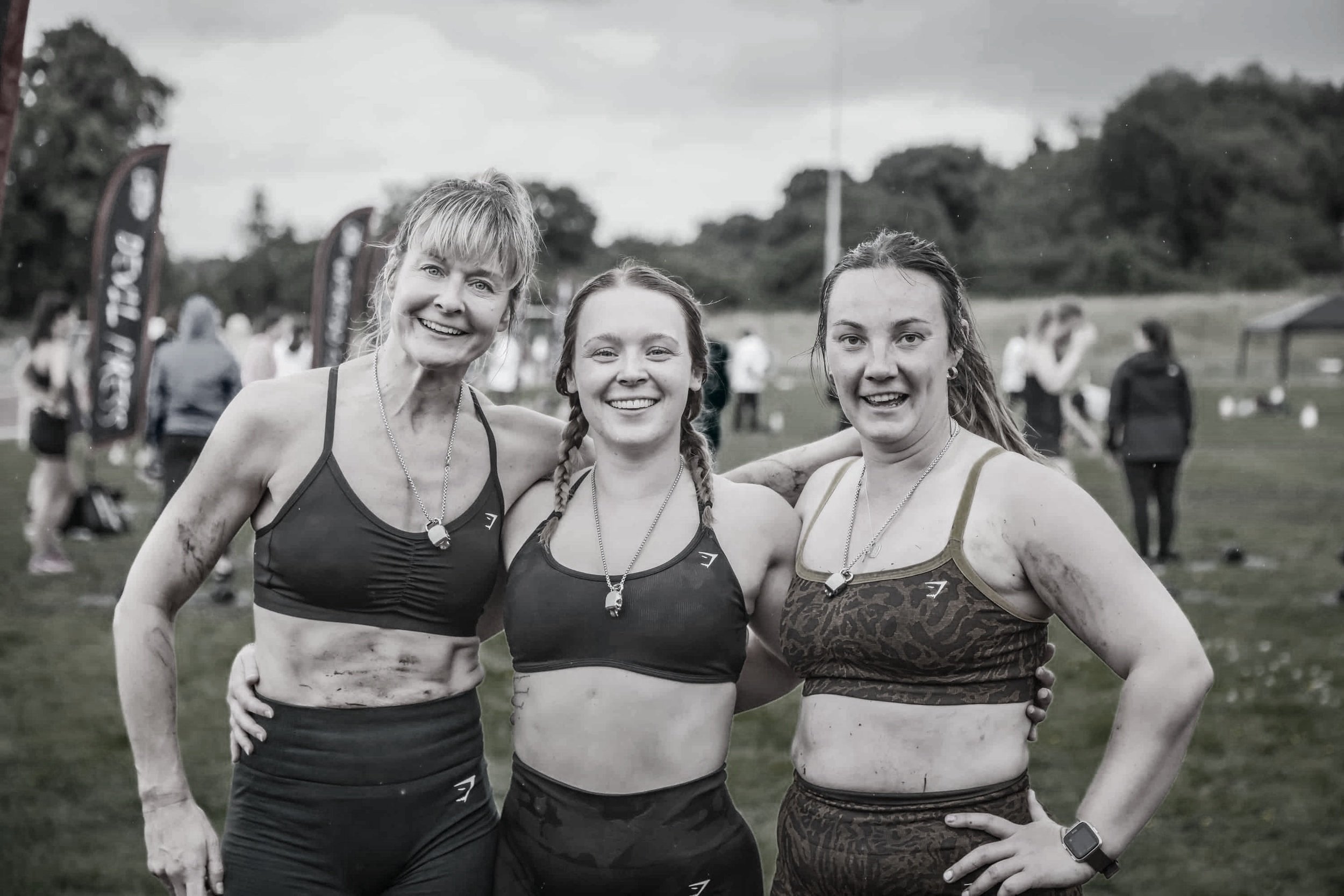Discover the Deadly Dozen Fitness Race Experience
The Deadly Dozen (DD) has been designed as one of the most challenging yet accessible fitness races in the world.
The race involves 12 x 400m runs, which we refer to as “Journeys”, and 12 x exercise stations, which we refer to as “Labours”. The Labour’s only use bodyweight (BW), kettlebell (KB), dumbbell (DB) and weight plate (WP) exercises. Therefore, race training is incredibly accessible in any setting, whether in a gym, at home or outdoors. Ultimately, an individual could effectively train for the event with just a pair of kettlebells.
Another benefit of using only KBs, DBs, and WPs is that they are easy to store and transport and extremely unlikely to break or be damaged.
Official Deadly Dozen races are held on athletics tracks (both outdoor and indoor) and involve running a 400m lap (2x 200m laps indoors) before crossing over into the centre, completing a Labour, and repeating the process until the athlete has completed all 12 Labours – 6 of the Labours move between a 30m lane (Distance Labours – D Labours) and six are stationary (Rep Labours – R Labours).
The Deadly Dozen Labours (exercises) have been selected to develop a well-rounded training program that creates the Half Dozen Fundamental Movements: Hinge, Squat, Lunge, Push, Pull, and Carry. These movements require some level of bracing and/or rotational movement.
The Deadly Dozen is NOT just a fitness race but an entire training methodology.
In short, the Deadly Dozen Method (DDM) divides training into three primary disciplines, which are collectively called the Deadly Dozen Triad (DDT).
The Deadly Dozen Triad:
1. Strength: Resistance training sessions (usually gym-based) concentrating on low and mid-volume sets with higher training intensities (heavier).
2. Labour Fitness: Circuit training sessions that include some or all of the Labours performed at higher volumes (for high reps or time). These sessions can include or not include Journeys (runs and other forms of cardio).
3. Journey Fitness: Running training sessions are usually split between long-duration work at lower intensities or interval work at higher intensities. However, Journey Fitness does not have to be a run; it can be a row, ski, cycle, etc.
Note: Alongside the main running-based event, variations such as Deadly Dozen Row, Deadly Dozen Ski and Deadly Dozen Cycle can also be practised: DD Row and Ski use the same Journey distance (400m), whereas DD Cycle doubles the Journey distance (800m).
Other potential Deadly Dozen variations include DD Swim (100m swim) or DD Climb, in which a rock wall or obstacle course is completed as a Journey.
The Deadly Dozen Fitness Race uses a Dozenal (duodecimal) system. Therefore, all distances and reps are based around the number 12 (a superior, highly composite number) and can be increased or decreased by 25, 50, or 75% while maintaining round numbers—this is a key element of the training methodology.
Race Structure:
400m Run
KB Farmers Carry: 240m
400m Run
KB Deadlift: 60 Reps
400m Run
DB Lunge: 60m
400m Run
DB Snatch: 60 Reps (Alternate)
400m Run
Burpee Broad Jump: 60m
400m Run
KB Goblet Squat: 60 Reps
400m Run
Plate Front Carry: 240m
400m Run
DB Push Press: 60 Reps
400m Run
Bear Crawl: 120m
400m Run
Plate Clean & Press: 60 Reps
400m Run
Plate Overhead Carry: 180m
400m Run
DB Devil Press: 20 Reps
Race Variations
Solo Race:
The Solo Race involves running the entire event as an individual.
The race has no time limit. However, each Labour (exercise) must be completed in the correct order, and athletes cannot move on until the Labour is completed. Athletes are seeded with our Seeding Labour before the event and set off in waves (two men and two women at a time).
If an athlete is unable to complete a Labour to the set standard (modified technique or range of motion, etc), their final race time will be followed by “(s)” which denotes that they have “scaled” the race.
Pairs Race:
The Pairs Race involves running the event in teams of two.
Both athletes run every 400m Journey together and are involved in completing each Labour. However, they can split each Labour down between them in any way they see fit.
Athletes can be same-sex or mixed - mixed teams use the male weights (and female-only teams use the female weights). Athletes can be any age combination (above 18).
If either athlete needs to scale a Labour, the final time will be followed by (s).
Relay Race:
The Relay Race involves running the event in teams of four.
Each athlete runs 1x Journey and 1x Labour before the next team member goes. Therefore, each athlete completes 3x Journeys and 3x Labours to complete the race - athletes must stick to their order, i.e., Athlete A does Labour 1, 5 & 9.
Athletes can be same-sex or mixed (2 x male + 2 x female) - mixed teams use the male weights (female-only teams use the female weights). Athletes can be any age combination (above 18).
If any athlete needs to scale a Labour, the final time will be followed by (s).

